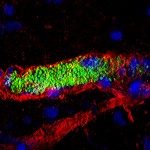Link to Pubmed [PMID] – 28385784
Haematologica 2017 07;102(7):1161-1172
Although the primary origin of sickle cell disease is a hemoglobin disorder, many types of cells contribute considerably to the pathophysiology of the disease. The adhesion of neutrophils to activated endothelium is critical in the pathophysiology of sickle cell disease and targeting neutrophils and their interactions with endothelium represents an important opportunity for the development of new therapeutics. We focused on endothelin-1, a mediator involved in neutrophil activation and recruitment in tissues, and investigated the involvement of the endothelin receptors in the interaction of neutrophils with endothelial cells. We used fluorescence intravital microscopy analyses of the microcirculation in sickle mice and quantitative microfluidic fluorescence microscopy of human blood. Both experiments on the mouse model and patients indicate that blocking endothelin receptors, particularly ET receptor, strongly influences neutrophil recruitment under inflammatory conditions in sickle cell disease. We show that human neutrophils have functional ET receptors with calcium signaling capability, leading to increased adhesion to the endothelium through effects on both endothelial cells and neutrophils. Intact ET function was found to be required for tumor necrosis factor α-dependent upregulation of CD11b on neutrophils. Furthermore, we confirmed that human neutrophils synthesize endothelin-1, which may be involved in autocrine and paracrine pathophysiological actions. Thus, the endothelin-ET axis should be considered as a cytokine-like potent pro-inflammatory pathway in sickle cell disease. Blockade of endothelin receptors, including ET, may provide major benefits for preventing or treating vaso-occlusive crises in sickle cell patients.

